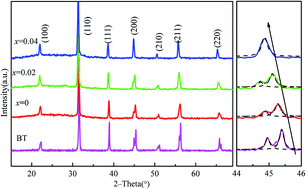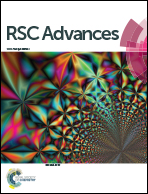Extended dielectric constant step from −80 °C to 336 °C in the BaTiO3–BiYO3–Ba(Fe0.5Nb0.5)O3 system
Abstract
Polycrystalline 0.8BaTiO3–(0.2 − x)BiYO3–xBa(Fe0.5Nb0.5)O3 (0.8BT–(0.2 − x)BY–xBFN) (x = 0–0.04) ceramics were fabricated via a conventional solid-state reaction method. The phase transition, microstructure and dielectric properties were obtained by X-ray diffraction and dielectric measurements as functions of chemical composition and temperature. A progressive decline in εrmax with increasing x leads to nearly temperature-stable dielectric properties over a wide temperature range. For x ≥ 0, dielectric measurements indicate relaxor behavior. Increasing the BFN content effectively improves the dielectric temperature stability of BT ceramics. For x = 0.02, εr = 590 ± 15% from −48 °C to 326 °C, and tan δ ≤ 0.02 across the temperature range of −13 °C to 156 °C. For x = 0.04, εr = 540 ± 15% from −80 °C to 336 °C, and tan δ ≤ 0.02 across the temperature range of −22 °C to 231 °C. The plot of ac conductivity for x = 0.04 shows the NTCR character of the compounds, and the activation energy of the dc conductivity is not far from the electron from second ionization energy of oxygen vacancies.


 Please wait while we load your content...
Please wait while we load your content...